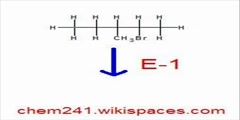Lec 17 - Reaction Analogies and Carbonyl Reactivity
"Lec 17 - Reaction Analogies and Carbonyl Reactivity" Freshman Organic Chemistry (CHEM 125) Continuing the examination of molecular orbital theory as a predictor of chemical reactivity, this lecture focuses on the close analogy among seemingly disparate organic chemistry reactions: acid-base, SN2 substitution, and E2 elimination. All these reactions involve breaking existing bonds where LUMOs have antibonding nodes while new bonds are being formed. The three-stage oxidation of ammonia by elemental chlorine is analyzed in the same terms. The analysis is extended to the reactivity of the carbonyl group and predicts the trajectory for attack by a high HOMO. This predicted trajectory was validated experimentally by Bürgi and Dunitz, who compared numerous crystal structures determined by X-ray diffraction. 00:00 - Chapter 1. Similarities Among Acid-Base, SN2 Substitution, and E2 Elimination Reactions 15:23 - Chapter 2. The Oxidation of Ammonia by Chlorine in Molecular Orbital Terms 26:05 - Chapter 3. Reactivity of the Carbonyl Group 36:11 - Chapter 4. Dunitz and Burgi's Experimental Results on Carbonyl Attack Trajectory Complete course materials are available at the Open Yale Courses website: http://open.yale.edu/courses This course was recorded in Fall 2008.
Video is embedded from external source so embedding is not available.
Video is embedded from external source so download is not available.
Channels: Chemistry (General)
Tags: Bürgi-Dunitz Angle SN2 substitution E2 elimination hydrazine
Uploaded by: yalefreshorganic ( Send Message ) on 05-09-2012.
Duration: 41m 44s
Here is the next lecture for this course
Diels-Alder Reaction- Highest Occupied Or ...
00:16 | 7549 viewsNucleophilic Substitution - SN1 and SN2
02:17 | 6859 viewsNucleophilic Substitution SN2
09:41 | 6205 viewsAldol condensation reaction (2)
08:51 | 8032 viewsElimination Reactions
04:46 | 5384 viewsE-1 Reaction of 2-bromo-3-methylpentane
04:13 | 10051 viewsSN1 reaction
00:12 | 9558 viewsLec 5- Electrophilic Aromatic Substitutio ...
01:18:17 | 2721 viewsLec 6- Directing Effects in Electrophilic ...
01:15:22 | 2689 viewsLec 7- Electrophilic Aromatic Substitutio ...
01:12:28 | 2986 viewsIllustrative Reactions ofElectrophilic Ar ...
08:59 | 13926 viewsPhysical reaction to stress and polygraph
02:57 | 9290 viewsReaction of Sodium & Chlorine (with subti ...
00:51 | 6484 viewsPhotosynthetic Reaction Center
01:07 | 8705 viewsReactions of Electrophilic Aromatic Subst ...
00:33 | 6768 viewsNo content is added to this lecture.
This video is a part of a lecture series from of Yale
















